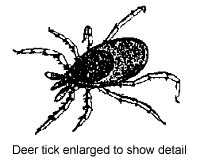Lyme Disease is spread by the tiny deer tick. Ticks feed on blood, and infected ticks transmit the disease as they feed. Although the deer tick prefers to feed on wild animals, especially mice, birds, opossum, raccoon, and deer, they will also feed on dogs, cats, livestock, and humans. When people visit or live near deer tick habitats, they run a high risk of contracting Lyme Disease. For your own safety, you should become familiar with tick habits and habitats, and you should learn how to prevent tick bites.
FAVORITE TICK HABITATS
Where you live, your hobbies, and your habits may influence your risk of a tick bite. Notice in particular these high-risk factors:
Many of these factors encourage wildlife near the home, and these animals may carry ticks. Mice in particular are known hosts of immature deer ticks and carriers of Lyme Disease. Reduce, remove, or avoid these risk factors as much as possible.
PERSONAL PROTECTION
Repellents contain the active ingredient permethrin (Duranon, Permethrin Tick Repellent, Permanone), or N,N-diethyl-meta-tolumide, usually called DEET (Off, Cutters, Muskol, etc.) Follow label directions. These products repel 82-100% of ticks.
TICK IDENTIFICATION Seventy percent of all Lyme Disease cases occur from the bite
of the immature (nymph) deer tick (See Figure 1). Before feeding,
nymphs are the size of a poppy seed with a dark head and translucent
body. After feeding, they swell and appear dark gray and round,
about the size of a mustard seed.
Seventy percent of all Lyme Disease cases occur from the bite
of the immature (nymph) deer tick (See Figure 1). Before feeding,
nymphs are the size of a poppy seed with a dark head and translucent
body. After feeding, they swell and appear dark gray and round,
about the size of a mustard seed.
Adult deer ticks are the size of a sesame seed before feeding; females have a black head and brick red abdomen. After feeding, they turn gray and swell to the size of a sunflower seed kernel.
Deer ticks are active all year round, as long as the temperature is over 35°F. Peak activity months are May-June (nymphs), and October-November (adults).
Ask your county extension agent for a free copy of the bulletin "Protect Yourself From Ticks and Lyme Disease" for specific ways to identify different ticks. The Lone Star tick may have a slight involvement in Lyme Disease transmission; the American Dog Tick is not known to be involved in Lyme Disease transmission.
FINDING AND REMOVING TICK
Remove ticks with tweezers only (bent, "needle-nose" tweezers are best). Do not use alcohol, nail polish, hot matches, petroleum jelly, or other methods to remove ticks. These methods may actually traumatize ticks causing them to regurgitate gut contents, which may include the Lyme Disease bacteria.
TICK CONTROL
Granular insecticides should be applied once in low-risk areas (late May/early June) and twice in high-risk sites (mid-May and early June). An early October treatment is optional. Focus treatment along the edge of the woods and 15 feet into the woods. These treatments have resulted in over 90 percent control in research trials.
Liquid insecticides should be sprayed on vegetation until they run off. Apply in mid-May, early June, and mid-June. Sprays targeting adult deer ticks may be applied after leaves have dropped from the trees, from November to April.
Damminix is a product that provides insectide-laced nesting material to mice. It kills immature ticks attached to mice in their burrows. Place it only in areas where mice frequent. Damminix may also be used in combination with the above insecticides.
Publication #: FS637
This document is apart of a series from the Rutgers Cooperative Extension, Rutgers, the State University of New Jersey. Publication date: September 1992.
Deborah Smith-Fiola, County Agricultural Agent, Ocean County, Rutgers, The State University of New Jersey, New Brunswick, NJ 08903.
Disclaimer and Reproduction Information: Information in NASD does not represent NIOSH policy. Information included in NASD appears by permission of the author and/or copyright holder. More